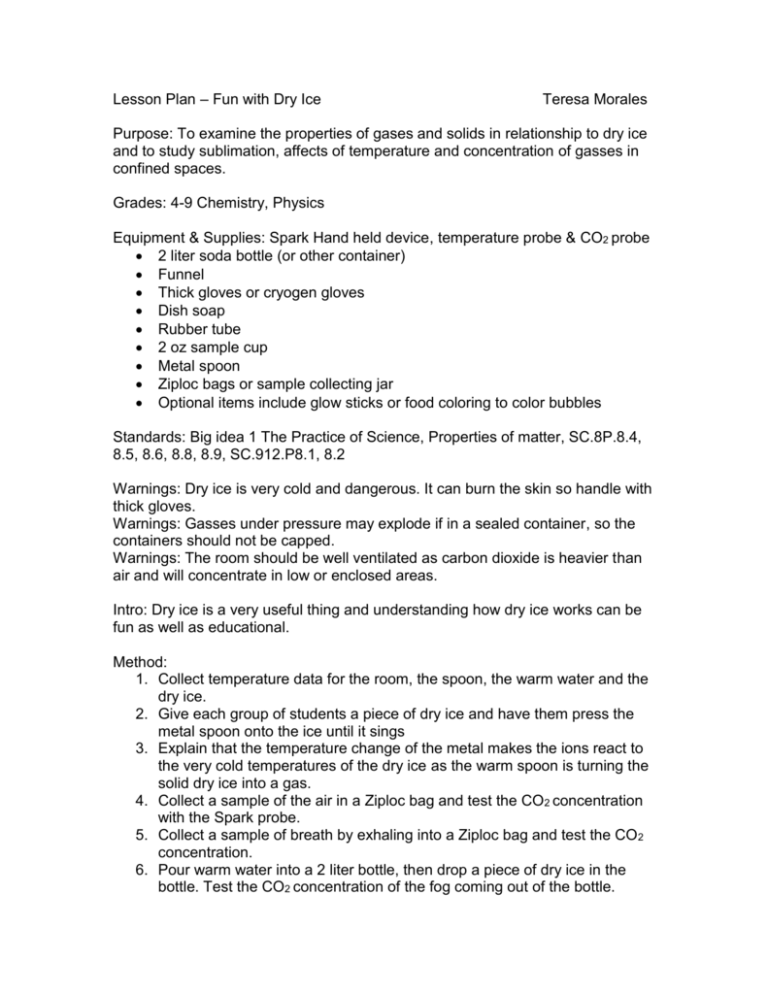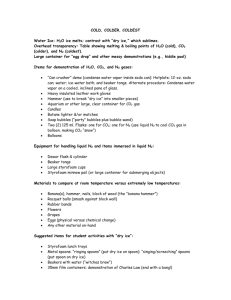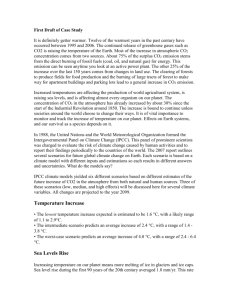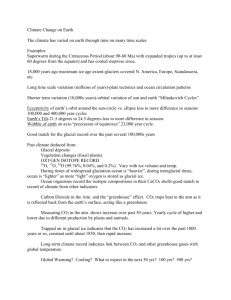Lesson Plan – Fun with Dry Ice Teresa Morales
advertisement

Lesson Plan – Fun with Dry Ice Teresa Morales Purpose: To examine the properties of gases and solids in relationship to dry ice and to study sublimation, affects of temperature and concentration of gasses in confined spaces. Grades: 4-9 Chemistry, Physics Equipment & Supplies: Spark Hand held device, temperature probe & CO2 probe 2 liter soda bottle (or other container) Funnel Thick gloves or cryogen gloves Dish soap Rubber tube 2 oz sample cup Metal spoon Ziploc bags or sample collecting jar Optional items include glow sticks or food coloring to color bubbles Standards: Big idea 1 The Practice of Science, Properties of matter, SC.8P.8.4, 8.5, 8.6, 8.8, 8.9, SC.912.P8.1, 8.2 Warnings: Dry ice is very cold and dangerous. It can burn the skin so handle with thick gloves. Warnings: Gasses under pressure may explode if in a sealed container, so the containers should not be capped. Warnings: The room should be well ventilated as carbon dioxide is heavier than air and will concentrate in low or enclosed areas. Intro: Dry ice is a very useful thing and understanding how dry ice works can be fun as well as educational. Method: 1. Collect temperature data for the room, the spoon, the warm water and the dry ice. 2. Give each group of students a piece of dry ice and have them press the metal spoon onto the ice until it sings 3. Explain that the temperature change of the metal makes the ions react to the very cold temperatures of the dry ice as the warm spoon is turning the solid dry ice into a gas. 4. Collect a sample of the air in a Ziploc bag and test the CO2 concentration with the Spark probe. 5. Collect a sample of breath by exhaling into a Ziploc bag and test the CO 2 concentration. 6. Pour warm water into a 2 liter bottle, then drop a piece of dry ice in the bottle. Test the CO2 concentration of the fog coming out of the bottle. 7. Create ghost bubbles by cutting the tops off the soda bottle. Make the hole smaller than the bottom of the funnel. 8. Cover the hole with the funnel and attach a length of rubber tubing onto the narrow end of the funnel. 9. Cut a small hole in the bottom of the 2 oz portion cup. Leave enough space to insert the rubbing tubing and the CO2 probe. 10. Dip the portion cup into a solution of soapy water and watch the bubble grow. 11. Measure the CO2 concentration inside the bubble and then shake the bubble free from the cup. When it hits the ground the bubble will burst releasing the foggy CO2. Questions: Why does the CO2 fog not rise like steam but sink? Why must the dry ice be handled with gloves on? What changes when the CO2 is forced through the narrow end of the tunnel? Does the temperature of the CO2 change when it is changed from a solid to a gas? Analysis: Dry ice is nothing more than carbon dioxide under pressure and cooled to the temperature of -109.3 degrees F. CO2 gas is heavier than air so it sinks. The process of going from a solid to a gas is called sublimination and this process happens at room temperature. Dry ice is used for refrigeration and shipping frozen foods. Carbon dioxide is also used in fire extinguishers.








